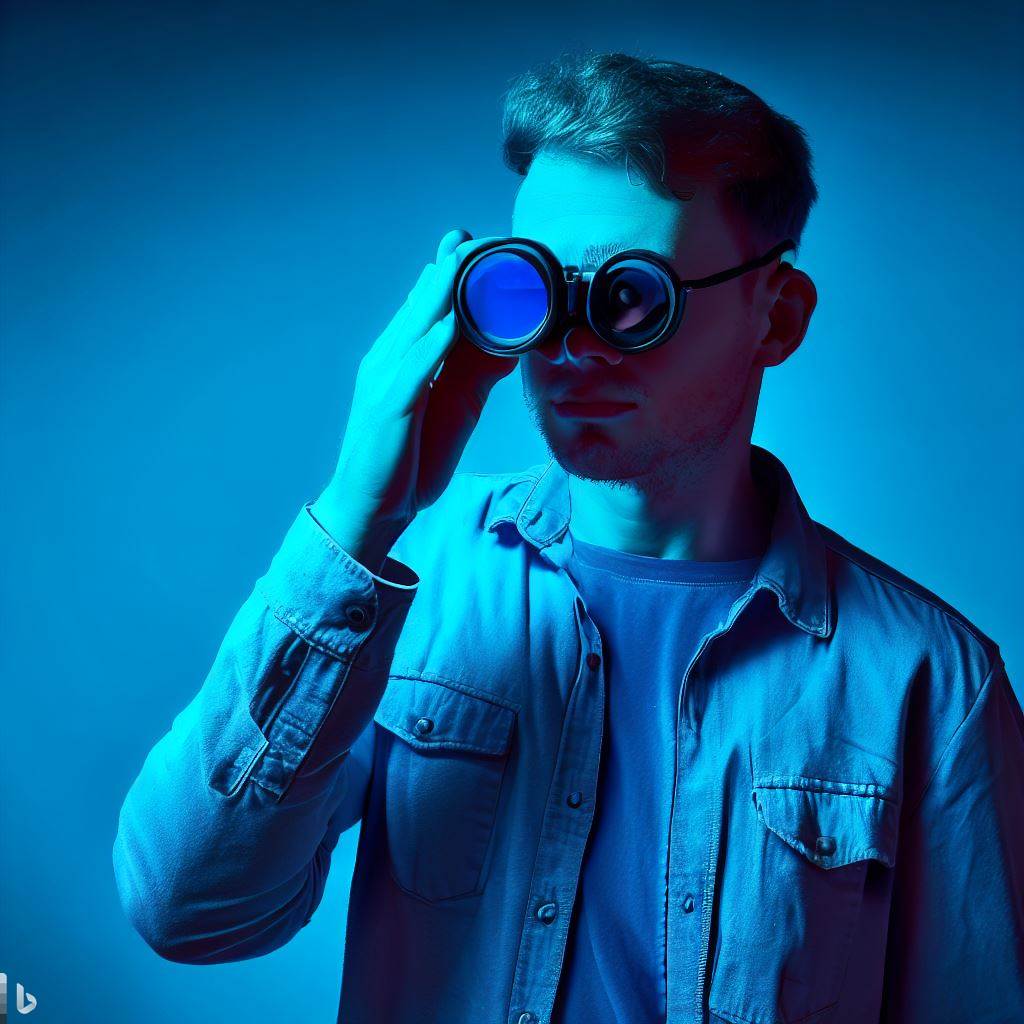

Imagine this scenario: you’re out in the dark, relying completely on your night vision device to guide your way. Suddenly, you’re blinded by a glaring light that hinders your ability to see clearly. It’s a frustrating and potentially dangerous situation.
In this article, we will explore some practical tips and techniques that can help you prevent blooming or glare in your night vision devices, ensuring a clear and optimized vision in the darkness.
Understanding Blooming and Glare in Night Vision Devices
Night vision devices are an invaluable tool when it comes to enhancing visibility in low-light conditions. However, two common issues that can affect the performance of these devices are blooming and glare. To fully understand how to prevent these issues, it is important to first define and comprehend what blooming and glare actually are.
Definition of Blooming
Blooming refers to the overflowing or spreading of light from bright sources that can cause surrounding areas to appear overly illuminated. It occurs when the intensity of a light source exceeds the capability of the image intensifier tube. As a result, the excessive light spills over into nearby areas, leading to a loss of detail and clarity in the image.
Definition of Glare
Glare occurs when bright light sources create a distracting and uncomfortable level of brightness in the field of view. This can hinder the ability to clearly see objects in the surrounding environment and negatively impact overall night vision capabilities.
Causes of Blooming
Several factors can contribute to the occurrence of blooming in night vision devices. These include:
- Brightness of Light Source: The intensity of the light source plays a significant role in causing blooming. The brighter the source, the more likely it is to exceed the device’s capacity, resulting in blooming.
- Proximity to Light Source: The distance between the night vision device and the light source can also influence the occurrence of blooming. The closer the device is to the light source, the greater the likelihood of blooming.
- Lens Quality: The quality of the lens can impact the occurrence of blooming. High-quality lenses generally have better anti-blooming properties, reducing the chances of blooming.
- Sensor Sensitivity: The sensitivity of the device’s sensor can affect its susceptibility to blooming. Devices with highly sensitive sensors may be more prone to blooming.
Causes of Glare
Similar to blooming, glare can be caused by various factors. These include:
- Bright Light Sources: The brightness of the light sources in the environment can contribute to the occurrence of glare. Strong, direct sources of light can create excessive brightness that impairs vision.
- Reflections: When light reflects off surfaces, such as glass or shiny objects, it can result in glare. This can be particularly problematic in urban or built-up areas with many reflective surfaces.
- Lens Coatings: The absence or poor quality of anti-reflective coatings on the lenses of night vision devices can lead to glare. These coatings help reduce the reflections and glare caused by ambient light.
Importance of Preventing Blooming and Glare
Preventing blooming and glare is crucial for maintaining optimal night vision capabilities. Failure to address these issues can have several negative consequences:
Effect on Night Vision
Blooming and glare can significantly impair night vision capabilities. They can obscure important details, reduce image clarity, and distort the perception of the overall environment. This, in turn, restricts the ability to detect potential threats or obstacles, compromising safety and overall performance in low-light conditions.
Safety Concerns
When blooming and glare occur, excessive brightness can cause discomfort to the eyes, making it difficult to focus on the intended target. This can lead to eye strain and even temporary blinding.
In situations where clear visibility is crucial, such as military operations or emergency response situations, these safety concerns are particularly heightened.
Reduced Performance
Blooming and glare can adversely affect the performance of night vision devices, rendering them less effective in the field. The loss of detail and clarity caused by these issues can hinder accurate target identification and tracking, reducing the overall effectiveness of the device.
Factors Influencing Blooming and Glare
Understanding the factors that contribute to blooming and glare is essential for effectively preventing these issues. Several key factors influence the occurrence of blooming and glare, including:
Amount of Ambient Light
The amount of ambient light present in the environment can impact the severity of blooming and glare. Dimly lit environments generally have a lower likelihood of experiencing these issues, while areas with bright ambient light may be more susceptible.
Proximity to Bright Light Sources
The proximity of night vision devices to bright light sources can greatly influence the occurrence of blooming and glare. Keeping a safe distance and avoiding direct exposure to strong light sources can help minimize the impact of these issues.
Lens Quality
The quality of the lenses used in night vision devices can greatly affect their susceptibility to blooming and glare. High-quality lenses with anti-blooming and anti-reflective properties can significantly mitigate these issues.
Sensor Sensitivity
The sensitivity of the sensor in the night vision device can also contribute to the occurrence of blooming. Devices with highly sensitive sensors may be more prone to blooming when exposed to bright light sources.
Maintaining Optimal Conditions
To minimize the occurrence of blooming and glare and ensure optimal performance of night vision devices, several preventive measures can be taken:
Use Dimmer Lights
When operating in low-light conditions, using dimmer lights can help reduce the chances of blooming and glare. Avoiding excessively bright light sources can go a long way in preventing these issues.
Control Ambient Light
Managing the amount of ambient light in the environment is crucial for preventing blooming and glare. Shielding the field of view from direct exposure to bright lights and reducing unnecessary sources of light can help maintain clear visibility.
Avoid Direct Exposure to Strong Light Sources
Direct exposure to strong light sources should be avoided whenever possible. Maintaining a safe distance from bright lights, such as vehicle headlights or other powerful light sources, can greatly reduce the occurrence of blooming and glare.
Ensure Proper Cleaning of Lenses
Regularly cleaning the lenses of night vision devices is essential for optimal performance. Dust, dirt, and smudges on the lenses can contribute to glare and reduce image clarity. Using proper cleaning techniques and materials will help maintain the integrity of the lenses and minimize these issues.
Using Optical Filters
Optical filters can provide additional protection against blooming and glare in night vision devices. Some commonly used filters include:
Polarizing Filters
Polarizing filters help reduce the intensity of reflected light, minimizing glare caused by shiny or reflective surfaces. By selectively filtering light waves, these filters can significantly enhance visibility and reduce discomfort.
Neutral Density Filters
Neutral density filters work by uniformly reducing the amount of light entering the device. They can be useful in situations where the ambient light is significantly brighter than desired, helping to prevent blooming and glare.
Infrared Cut-off Filters
Infrared cut-off filters are designed to block unwanted infrared light, which can cause blooming and other issues in night vision devices. These filters help ensure that only the desired visible light is transmitted, resulting in clearer images.
Adjusting Device Settings
Most night vision devices come equipped with various settings that allow users to adjust the performance and optimize the image quality. Two key settings that can help address blooming and glare are:
Gain Control
Gain control adjusts the amplification of the incoming light, allowing users to regulate the brightness of the image. By setting the gain appropriately, users can prevent excessive brightness and minimize the occurrence of blooming and glare.
Brightness and Contrast Adjustment
Night vision devices often have brightness and contrast adjustment settings that enable users to fine-tune the image quality. Properly adjusting these settings can greatly help in reducing the visibility of blooming and glare, ensuring a clearer and more usable image.
Proper Device Calibration
Ensuring the proper calibration of night vision devices is essential for optimal performance and reducing the occurrence of blooming and glare. Two key aspects of device calibration are:
White Balance Calibration
White balance calibration ensures accurate color reproduction and image quality. Properly calibrating the device’s white balance helps minimize color cast and subsequently reduces the visibility of blooming and glare.
Lens Alignment
Aligning the lenses of the night vision device can improve focus and image clarity, consequently reducing the occurrence of blooming. Proper alignment helps ensure that light is accurately captured and transmitted through the device, resulting in a clearer and more detailed image.
Periodic Maintenance and Inspection
Regular maintenance and inspection of night vision devices are necessary to ensure optimal performance and longevity. Some key maintenance practices include:
Regular Cleaning
Routine cleaning of the lenses and device components is essential for removing dirt, dust, and smudges that can contribute to blooming and glare. Following proper cleaning procedures and using suitable cleaning materials will help preserve the integrity of the device and improve overall image quality.
Inspection for Damage or Misalignment
Regularly inspecting night vision devices for any signs of damage or misalignment is crucial. Any issues, such as cracked lenses or misaligned components, can affect the device’s performance and increase the likelihood of blooming and glare. Addressing these issues promptly will help maintain optimal conditions.
Professional Servicing
Periodic professional servicing is recommended to ensure thorough maintenance and assessment of night vision devices. Professional technicians can identify and address any underlying issues that may contribute to blooming and glare, ensuring the devices function at their best.
Reducing Glare
In addition to the preventive measures discussed above, a couple of specific methods can be employed to further reduce glare:
Anti-reflective Coatings
Applying high-quality anti-reflective coatings to the lenses of night vision devices can significantly reduce the occurrence of glare. These coatings help minimize reflections and improve light transmission, resulting in clearer images and less eyestrain.
Adjusting Eye Relief
Eye relief refers to the distance between the eyepiece of the night vision device and the user’s eye. Adjusting the eye relief to the correct distance can help minimize the impact of glare and reduce eye discomfort.
Conclusion
Preventing blooming and glare in night vision devices is crucial for maintaining optimal visibility and performance in low-light conditions.
By understanding the causes and factors that contribute to these issues, as well as implementing appropriate preventive measures, users can ensure clear, detailed, and comfortable night vision experiences.
From managing ambient light and using optical filters to adjusting device settings and maintaining proper calibration, it is possible to mitigate the impact of blooming and glare, ultimately enhancing the effectiveness of night vision devices.
By taking the necessary steps to prevent these issues, users can maximize their night vision capabilities and operate with confidence in any low-light scenario.
How Do I Minimize Noise When Using Night Vision For Hunting?
What Type Of Batteries Do Most Night Vision Devices Use?
Can I Use Night Vision For Hunting Hogs Or Wild Boars?
Are There Night Vision Scopes With Range-Finding Capabilities?





